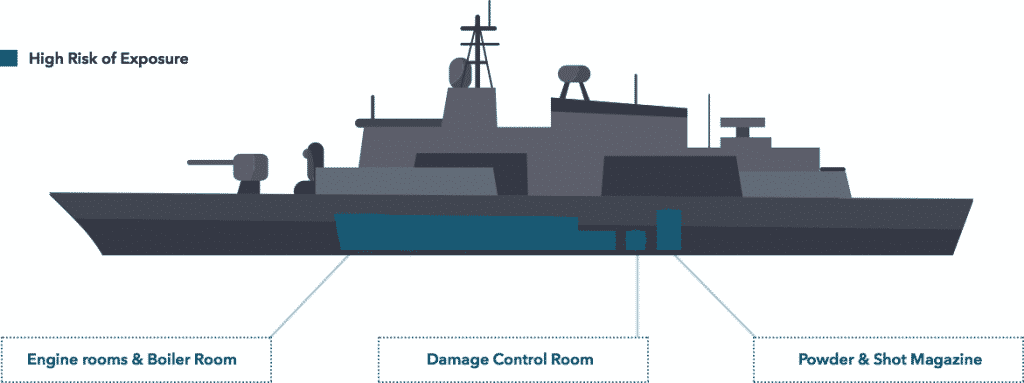Why Do So Many Navy Veterans Have Mesothelioma?
Veterans of any branch of the military have higher rates of mesothelioma than the general population. The rate is highest among Navy veterans because of how extensively the U.S. Navy used asbestos in its ships.
For the middle decades of the 20th century, asbestos was a component of many ships, both military and civilian. Not only did veterans work around asbestos, but the air on ships was often poorly ventilated, making exposure likely.
How Can Navy Veterans with Mesothelioma Get Compensation?
Asbestos in Navy ships was prevalent in the past, which put many sailors at risk of developing mesothelioma later as veterans. If you developed mesothelioma or another asbestos illness after serving in the Navy, you are entitled to compensation.
Navy veterans can seek compensation through VA benefits, lawsuits against manufacturers of asbestos materials, and asbestos trust funds. Talk to an asbestos law firm to find out what your best options for compensation are.
How Do Veterans Prove They Were Exposed to Asbestos in the Navy?
To get VA benefits, you must show that you have an asbestos illness and that you encountered asbestos during your time in the Navy. You must have:
- Medical records showing you have an illness like mesothelioma
- Statements from doctors to prove your illness resulted from asbestos exposure
- Military service records to show where, when, and in what capacity you served
Often, your job and time in the Navy are enough to prove you likely encountered asbestos that caused your illness.
How and When Did the Navy Use Asbestos?

Asbestos use was nothing new in the years leading up to World War II, but around 1939, shipbuilding in the Navy accelerated as entry into the war seemed inevitable. The military began stockpiling materials, including asbestos, and making new ships to prepare for what was coming.

It wasn’t until the 1970s, when the U.S. government began regulating the use of asbestos, that Navy ships slowed the use of the mineral. Many veterans of World War II, the Korean War, and the Vietnam War were exposed to asbestos because of working on Navy ships.[2]
Why Did the Navy Use So Much Asbestos?
Asbestos is a natural mineral that people have used for thousands of years. It is abundant and inexpensive and has unique properties that make it useful for many applications, especially insulation and fireproofing.[3]
These properties have made asbestos a popular material in shipbuilding in both civilian industries and the U.S. Navy. Fires can be deadly out at sea, so protecting ships from catching fire is crucial.
Also important are insulating pipes, boilers, engines, and other parts of the ship that are heated. Asbestos is easy to mold and lightweight, and for all these reasons, many Navy veterans worked with or were exposed to asbestos during their service. [1]
Where Were Veterans Exposed to Asbestos on Navy Ships?
Asbestos on ships of all kinds, including U.S. Navy ships, is found throughout the structure:
- The boiler rooms of ships contained asbestos because they produced so much heat and required insulation.
- The pipes and ducts running to and from the boiler also had to be insulated.
- These ran all over the ships and even through the living and eating quarters of the sailors.
- Men and women who worked in the boiler room were more vulnerable to asbestos exposure than other sailors.[4]
- Pumps, valves, and gaskets also contained asbestos.
- These materials were used in the mechanical pumps that powered the heating, cooling, bilge systems, and other parts of the ships.
- Those Navy members who worked on repairing these parts of ships now have the highest rates of mesothelioma and other asbestos-related illnesses.
Although some were at greater risk than others, all servicemen and women on board experienced some degree of exposure risks.
Asbestos was nearly everywhere onboard: flooring, wall panels, cables, packing materials, adhesives, deck materials, bedding, fireproof materials, and fireproof clothing.
Which Navy Jobs Had the Greatest Risk of Asbestos Exposure?
Certain Navy veterans are more likely to suffer from asbestos illnesses than others, depending on the jobs they held on ships:[2]
- Boiler room workers
- Pump maintenance
- Electricians
- Laggers
- Machinists
- Pipefitters
- Gunner’s mates
- Damage controlmen
- Firefighters
- Maintenance technicians
- Water tenders
- Welders
Workers in Navy shipyards also risked exposure to asbestos. This includes both military members and civilians who built, maintained, and repaired ships.
Materials and Components with Asbestos on Navy Ships
Nearly every area of Navy ships contained asbestos at one time. Some of the asbestos products the U.S. Navy used include:
- Insulation, especially around pipes and boilers
- Adhesives
- Fireproofing textiles and firefighting and safety gear
- Heat paneling
- Electrical cables
- Gaskets
- Packing materials
- Paneling
- Paint
- Flooring and ceiling tiles
- Pumps
- Paint
- Valves
Navy Ships with Asbestos
Every type of ship built and used by the U.S. Navy during a certain period of time contained asbestos. These are some of the types of navy ships that exposed sailors and officers to asbestos:
- Aircraft carriers
- Auxiliary ships
- Battleships
- Cruisers
- Destroyers
- Navy minesweepers
- Submarines
When Did the Navy Stop Using Asbestos?
The Navy stopped actively using asbestos on ships in the 1980s. Eliminating or encapsulating asbestos on ships and at bases took many more years.
Asbestos should not be a concern on ships now, even if it is present. Once encapsulated, asbestos is safe. It poses a risk if it is damaged, deteriorates, or otherwise becomes exposed and releases fibers into the air.
Are Navy Veterans Exposed to Asbestos Still?
Once out of military service, veterans no longer face exposure risks from military ships or bases. However, many veterans continue working in the same kinds of jobs they had while serving in the military. This can put them at risk of ongoing exposure to asbestos.
For instance, veterans who worked with boilers might go on to get civilian jobs in the same industry. While asbestos is no longer used in the same way it was in the past, today’s workers still face exposure to older materials in their workplaces.
The Dangers of Asbestos Exposure for Navy Veterans
While not all veterans will experience illness from asbestos exposure, the consequences for too many have included damaging and deadly diseases, including cancer.[6]
When a person breathes in asbestos fibers, they get lodged in tissues, especially in and around the lungs, and cause damage. Asbestosis is a chronic lung disease that may be triggered by inhaled asbestos. It causes coughing and difficulty breathing. It is not curable and is progressive.
Lung cancer can also be caused by asbestos and is often deadly and difficult to treat. Mesothelioma also results from asbestos exposure. It is a rare and aggressive type of cancer that most commonly affects the lining of the lungs or abdomen. Mesothelioma rates are higher in U.S. Navy veterans than in other population groups.
Navy veterans exposed to asbestos during wartime or non-active duty service did not realize the danger they were in. Many were diagnosed with these illnesses decades later. By the time most of these illnesses are diagnosed, they are very difficult to treat and often deadly.
Why Are Navy Veterans Still Getting Sick?
Exposure to asbestos causes damage that accumulates over years and decades. The latency period is the time from exposure to diagnosis. The latency period for mesothelioma can be as long as 60 years. If you served in the 1960s or 1970s, you could still get a diagnosis now.
U.S. Navy Asbestos Medical Surveillance Program

When the dangers of asbestos became clear in the 1970s, the U.S. Navy started AMSP, the Asbestos Medical Surveillance Program.
The program was put in place to monitor the health of veterans and civilians who worked on or near Navy ships and who were likely to have been exposed to asbestos.
The purpose is to detect any asbestos-related illnesses early. The earlier these illnesses are diagnosed, the easier it is to treat them and the better the prognosis for patients.[7]
Were Merchant Mariners Also Exposed to Asbestos?

The U.S. Merchant Marine, civilian ships that support the U.S. military, also contained asbestos. These civilians were active in World War II and were a crucial part of the war effort.
Mariners were exposed to asbestos in the same ways that sailors were aboard Navy and civilian ships.
A study of Merchant Mariners found that one-third had some type of anomaly in the lungs that could lead to mesothelioma. These crucial support workers for the U.S. Navy have suffered poor health because of asbestos exposure.[8]
What Should I Do if I Was Exposed to Asbestos in the Navy?
If you know or suspect you encountered asbestos on U.S. Navy ships, talk to your doctor right away. You should be screened for asbestos-related illnesses.
If you get a diagnosis of mesothelioma or another asbestos disease, seek out specialists to start treatment immediately. The U.S. Department of Veterans Affairs (VA) facilities in Boston and Los Angeles have experts in mesothelioma on staff.
You may not know if you were exposed to asbestos, but if you served before the 1980s, it’s likely. You should be especially concerned if you had any of the highest-risk jobs or worked in cramped, poorly ventilated areas of a ship.
You should also contact an experienced mesothelioma or asbestos lawyer. They can help you navigate the legal system and the VA to ensure you get the compensation you deserve. Asbestos illnesses are costly. Compensation can help cover your medical expenses.
Is Mesothelioma Considered a Disability by the VA?
Yes, the VA rates mesothelioma as 100% disabling. If you can connect your illness to asbestos exposure during active service, you qualify for disability benefits.
The VA also recognizes lung cancer, asbestosis, pleural plaques, and other asbestos illnesses as disabling. The disability rating for these conditions depends on the extent of your illness and symptoms.
Do Navy Veterans Get Compensation for Lung Cancer?
Yes, U.S. Navy veterans can also be compensated and get benefits for lung cancer. As with mesothelioma, if you can connect cancer to exposure during military service, you can apply for benefits.
Asbestos exposure doesn’t just cause mesothelioma. It can also cause lung cancer. In fact, lung cancer is a more common asbestos-related disease than mesothelioma. Because there are other causes of lung cancer, it is not always as easy to connect it to asbestos exposure.
Compensation and Benefits for Navy Veterans
Both civilians and service members can seek compensation for asbestos exposure. Companies that produced and distributed asbestos products are considered liable for exposure and illness. The VA also offers benefits for veterans exposed during service.
VA Benefits
The VA provides benefits for Navy veterans who were exposed to asbestos during service and their families. The types of compensation these veterans are eligible for include:
- Disability compensation
- Dependency and indemnity compensation
- Special and monthly disability
- Health care at VA medical centers and hospitals[9]
Mesothelioma Lawsuit
A lawsuit is another option for seeking compensation as a Navy veteran. Veterans or their surviving families may sue the manufacturers of materials that contain asbestos. These companies may be liable for having supplied the military with harmful materials.
Some veterans have earned compensation this way by filing a lawsuit against a company. They include the family of one veteran who died of mesothelioma and recovered $10 million from several asbestos materials manufacturers.
Most lawsuits end in settlements. The average amount for a mesothelioma settlement is typically between $1 million and $1.4 million.
Asbestos Trust Fund Claims
If a company that supplied asbestos materials to the Navy went out of business or filed for bankruptcy, you may not be able to sue. The company probably set up a trust fund to compensate victims. You can file a claim with one of these trusts to receive compensation.
How to Apply for VA Benefits
The process for applying for VA benefits can be confusing and lengthy. Consider working with a Veteran Service Officer or a mesothelioma lawyer to get the best results.
You will need to fill out specific forms to get benefits, provide medical records, and show service records to prove you were exposed to asbestos.
Mesothelioma Treatment for Navy Veterans and VA Medical Care
In addition to monetary compensation from the VA, veterans with mesothelioma can get world-class healthcare at VA facilities. The best VA hospitals for mesothelioma treatment are:
- VA Boston Healthcare System. The VA in Boston has affiliations with the Dana-Farber Cancer Institute, Harvard Medical Center, and Brigham and Women’s Hospital. These affiliations include some of the top treatment centers and specialists for mesothelioma, like Dr. Abraham Lebenthal.
- VA Greater Los Angeles Healthcare System. In Los Angeles, patients have access to UCLA’s Comprehensive Mesothelioma Program and Dr. Robert Cameron, a mesothelioma specialist.
If you are a veteran or the dependent of a veteran who was exposed to asbestos during service and became ill, you have the right to ask for compensation. Contact an asbestos lawyer to find out what your options are and how to proceed.

Mary Ellen Ellis
WriterMary Ellen Ellis has been the head writer for Mesothelioma.net since 2016. With hundreds of mesothelioma and asbestos articles to her credit, she is one of the most experienced writers on these topics. Her degrees and background in science and education help her explain complicated medical topics for a wider audience. Mary Ellen takes pride in providing her readers with the critical information they need following a diagnosis of an asbestos-related illness.

Dave Foster
Page EditorDave has been a mesothelioma Patient Advocate for over 10 years. He consistently attends all major national and international mesothelioma meetings. In doing so, he is able to stay on top of the latest treatments, clinical trials, and research results. He also personally meets with mesothelioma patients and their families and connects them with the best medical specialists and legal representatives available.
References
- War Related Illness and Injury Study Center. (2024, May). Exposure to Asbestos.
Retrieved from: https://www.warrelatedillness.va.gov/WARRELATEDILLNESS/education/factsheets/asbestos-exposure.pdf - Franke, K. and Paustenbach, D. (2011). Government and Navy Knowledge Regarding Health Hazards of Asbestos: A State of the Science Evaluation (1900 to 1970). Inhalation Toxicology. 23(Supp3), 1-20.
Retrieved from: https://www.tandfonline.com/doi/pdf/10.3109/08958378.2011.643417 - Environmental Protection Agency. (2024, August 2). Learn About Asbestos.
Retrieved from: https://www.epa.gov/asbestos/learn-about-asbestos - Rushworth, D.H. (2008, October 29). The Navy and Asbestos Thermal Insulation. Naval Engineers Journal. 17, 35-48.
Retrieved from: https://onlinelibrary.wiley.com/doi/abs/10.1111/j.1559-3584.2005.tb00336.x - Till, J.E., Beck, H.L., Boice, J.D., Mohler, H.J., Mumma, M.T., Aanenson, J.W. and Grogan, H.A. (2019, January 8). Asbestos Exposure and Mesothelioma Mortality Among Atomic Veterans. International Journal of Radiation Biology. DOI: 10.1080/09553002.2018.1551641.
Retrieved from: https://www.tandfonline.com/doi/abs/10.1080/09553002.2018.1551641 - U.S. Department of Veterans Affairs. (2025, April 21). Public Health. Asbestos.
Retrieved from: https://www.publichealth.va.gov/exposures/asbestos/index.asp?_ga=2.111440196.193094524.1547223378-765586305.1547062781 - Department of the Navy Bureau of Medicine and Surgery. (n.d.). Process and Protocol.
Retrieved from: https://www.med.navy.mil/Navy-and-Marine-Corps-Force-Health-Protection-Command/Environmental-Health/Occupational-and-Environmental-Medicine/Occupational-and-Environmental-Medicine-Division/Surveillance-and-Certification-Exam/Process-and-Protocol/ - Selikoff, I.J., Lilis R. & Levin, G. (1990). Asbestotic Radiological Abnormalities Among United States Merchant Marine Seamen. Br. J. Ind. Med., 47(5), 292-7.
Retrieved from: https://www.ncbi.nlm.nih.gov/pmc/articles/PMC1035162/?pageindex=1&tool=pmcentrez - U.S. Department of Vetereans Affairs. (2025, June 23). VA Benefits for Service Members.
Retrieved from: https://www.va.gov/service-member-benefits/


